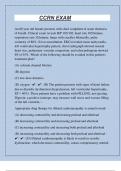CCRN EXAM
An 80 year old female presents with chief complaint of acute shortness
of breath. Clinical exam reveals B/P 182/102, heart rate 105/minute,
respiratory rate 32/minute, lungs with crackles bilaterally, pulse
oximetry of 88%, S4 on auscultation. EKG revealed sinus tachycardia,
left ventricular hypertrophy pattern, chest radiograph showed normal
heart size, pulmonary vascular congestion, and echocardiogram showed
EF of 55%. Which of the following should be avoided in this patient's
treatment plan?
(A) calcium channel blocker
(B) digoxin
(C) low-dose diuretics
(D) oxygen - ✔ ✔ (B) The patient presents with signs of heart failure
due to diastolic dysfunction (hypertension, left ventricular hypertrophy,
EF > 40%). These patients have a problem with FILLING, not ejecting.
Digoxin, a positive inotrope, may increase wall stress and worsen filling
of the left ventricle.
Appropriate drug therapy for dilated cardiomyopathy is aimed toward:
(A) decreasing contractility and decreasing preload and afterload
(B) decreasing contractility and increasing preload and afterload
(C) increasing contractility and increasing both preload and afterload
(D) increasing contractility and decreasing both preload and afterload -
✔ ✔ (D) Dilated cardiomyopathy is likely to result in systolic
dysfunction, which decreases contractility, causes compensatory arterial
,constriction , and results in a higher left ventricular preload. To treat
this, therapy is aimed at increasing contractility, decreasing afterload
(arterial constriction), and decreasing preload that is too high.
EKG changes associated with ST-elevation myocardial infarction
(STEMI) affecting the lateral wall would include changes in which of
the following leads?
(A) II, III, and aVF
(B) V1, V2, V3
(C) V2, V3, V4
(D) V5, V6, I, aVL - ✔ ✔ (D) V5, V6 represents the lower lateral
wall of the left ventricle and I, aVL represents the high lateral wall of the
left ventricle, supplied by the left circumflex artery in most of the
population.
A 58 year old patient developed chest pain that he scored as an "8"
Rapid assessment included profuse diaphoresis, B/P 78/52, heart rate
104/minute, respiratory rate 20/minute, lungs clear, and SpO2 98%. The
patient is currently connected to the bedside monitor with a nasal
cannula at 2 L/min in place and intravenous fluids, 0.9 NS at a rate of 10
ml/hour. Which of the following sequences of interventions would be
the most appropriate for the nurse at this time?
(A) give a chewable aspirin, do an EKG, and start a fluid bolus
(B) give NTG sublingual, increase the FiO2 and give morphine
(C) do an EKG, give NTG sublingual, and give a chewable aspirin
(D) start a fluid bolus, give a chewable aspirin, and do an EKG - ✔ ✔
(D) The clinical description may be that of acute coronary syndrome
, complicated by hypotension. Addressing the hypotension is a priority as
this is further decreasing coronary artery perfusion. A fluid bolus would
address hypotension, and no contraindications seem to be present for a
fluid bolus as lungs are clear. Aspirin is indicated for acutely chest pain
and could be given while preparing to do the EKG, which is needed to
help make the diagnosis.
A 59 year old male is admitted complaining of chest pain and dyspnea.
ST elevation and T wave inversion were seen on the EKG in V2,V3 and
V4. IV thrombolytic therapy was started in ED. Indications of successful
reperfusion would include all of the following except:
(A) pain cessation
(B) decrease in CK or troponin
(C) reversal of ST segment elevation with return to baseline
(D) short runs of ventricular tachycardia - ✔ ✔ (B)Coronary artery
reperfusion due to PCI or fibrinolysis results in an ELEVATION of
creatinine kinase (CK) or troponin, not decrease. The theory is that the
return of blood flow distal to the occlusion can result in 'reperfusion
injury' of the muscle, elevating cardiac biomarkers.
The other 3 choices are indicators of reperfusion: Pain cessation,
reversal of ST segment elevation with return to baseline, short runs of
ventricular tachycardia.
A patient complains of sudden dyspnea 5 days S/P acute MI (ST
elevation in II, III, and aVF, with ST depression in I and aVL). The
patient is anxious, diaphoretic, and hypotensive. Examination reveals the
development of a loud holosystolic murmur at the apex. What is the
most likely cause of this patient's deterioration?




